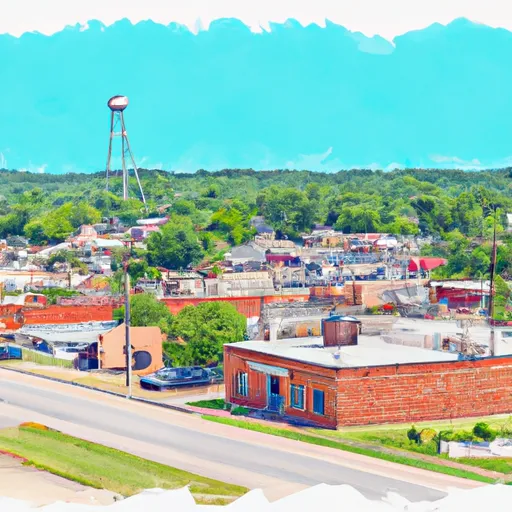-
 Snoflo Premium
Snoflo Premium
Get unlimited access to all our content
With no Ad interruptions! - Start Your Free Trial Login with existing account
Fort-Gibson
Eden Index
Climate
8.3
•
Recreation
5.7
•
Community
2.3
•
Safeguard
5.9/10

Fort Gibson is a town in Muskogee County, Oklahoma, situated on the banks of the Arkansas River. The climate is humid subtropical, with hot summers and mild winters. The hydrology constituents of the area include the Arkansas River and several smaller tributaries. Outdoor recreation opportunities include fishing, boating, and camping at Fort Gibson Lake, which spans over 19,000 acres and is home to a variety of fish species such as catfish, bass, and crappie. The area also offers hiking and bird watching at the Fort Gibson Wildlife Management Area, which covers over 21,000 acres of diverse habitat for over 300 bird species. Other attractions in the area include the Fort Gibson Historic Site and the Three Forks Nature Center.
What is the Eden Index?
The Snoflo Eden Index serves as a comprehensive rating system for regions, evaluating their desirability through a holistic assessment of climate health, outdoor recreation opportunities, and natural disaster risk, acknowledging the profound impact of these factors on livability and well-being.
Climate Health Indicator (CHI): 8.3
Fort-Gibson receives approximately
1119mm of rain per year,
with humidity levels near 81%
and air temperatures averaging around
16°C.
Fort-Gibson has a plant hardyness factor of
7, meaning
plants and agriculture in this region tend to thrive during the non-winter months.
By considering the ideal temperature range, reliable water supplies, clean air, and stable seasonal rain or snowpacks, the Climate Health Indicator (CHI) underscores the significance of a healthy climate as the foundation for quality living.
A healthy climate is paramount for ensuring a high quality of life and livability in a region, fostering both physical well-being and environmental harmony. This can be characterized by ideal temperatures, reliable access to water supplies, clean air, and consistent seasonal rain or snowpacks.
Weather Forecast
Streamflow Conditions
Robert S. Kerr Reservoir
Area Rivers
Robert S. Kerr Reservoir
Snowpack Depths
Robert S. Kerr Reservoir
Reservoir Storage Capacity
Robert S. Kerr Reservoir
Groundwater Levels
Recreational Opportunity Index (ROI): 5.7
The Recreational Opportunity Index (ROI) recognizes the value of outdoor recreational options, such as parks, hiking trails, camping sites, and fishing spots, while acknowledging that climate plays a pivotal role in ensuring the comfort and consistency of these experiences.
Access to outdoor recreational opportunities, encompassing activities such as parks, hiking, camping, and fishing, is crucial for overall well-being, and the climate plays a pivotal role in enabling and enhancing these experiences, ensuring that individuals can engage in nature-based activities comfortably and consistently.
Camping Areas
| Campground | Campsites | Reservations | Toilets | Showers | Elevation |
|---|---|---|---|---|---|
| Clayton Lake State Park | None | 738 ft | |||
| Virgil Point - Hugo Lake | None | 452 ft | |||
| Turkey Creek - Pine Creek Lake | 31 | 458 ft | |||
| Little River - Pine Creek Lake | None | 537 ft | |||
| Lost Rapids - Pine Creek Lake | None | 492 ft | |||
| Hugo Lake - Kiamichi State Park | None | 468 ft | |||
| Kiamichi Park - Hugo Lake | None | 464 ft | |||
| Sardis Cove | None | 688 ft | |||
| Raymond Gary State Park | None | 480 ft | |||
| Pine Creek Cove - Pine Creek Lake | None | 462 ft |
Nearby Fishing
Catastrophe Safeguard Index (CSI):
The Catastrophe Safeguard Index (CSI) recognizes that natural disaster risk, encompassing floods, fires, hurricanes, and tornadoes, can drastically affect safety and the overall appeal of an area.
The level of natural disaster risk in a region significantly affects safety and the overall livability, with climate change amplifying these risks by potentially increasing the frequency and intensity of events like floods, fires, hurricanes, and tornadoes, thereby posing substantial challenges to community resilience and well-being.
Community Resilience Indicator (CRI): 2.3
The Community Resilience Indicator (CRI) recognizes that education, healthcare, and socioeconomics are crucial to the well-being of a region. The CRI acknowledges the profound impact of these elements on residents' overall quality of life. By evaluating educational resources, healthcare accessibility, and economic inclusivity, the index captures the essential aspects that contribute to a thriving community, fostering resident satisfaction, equity, and social cohesion.

